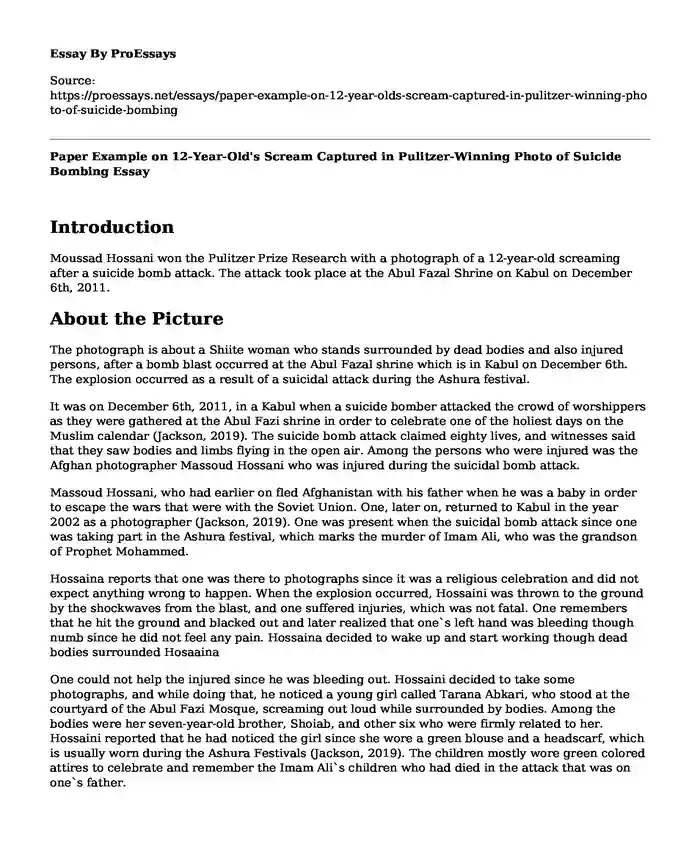Introduction
Moussad Hossani won the Pulitzer Prize Research with a photograph of a 12-year-old screaming after a suicide bomb attack. The attack took place at the Abul Fazal Shrine on Kabul on December 6th, 2011.
About the Picture
The photograph is about a Shiite woman who stands surrounded by dead bodies and also injured persons, after a bomb blast occurred at the Abul Fazal shrine which is in Kabul on December 6th. The explosion occurred as a result of a suicidal attack during the Ashura festival.
It was on December 6th, 2011, in a Kabul when a suicide bomber attacked the crowd of worshippers as they were gathered at the Abul Fazi shrine in order to celebrate one of the holiest days on the Muslim calendar (Jackson, 2019). The suicide bomb attack claimed eighty lives, and witnesses said that they saw bodies and limbs flying in the open air. Among the persons who were injured was the Afghan photographer Massoud Hossani who was injured during the suicidal bomb attack.
Massoud Hossani, who had earlier on fled Afghanistan with his father when he was a baby in order to escape the wars that were with the Soviet Union. One, later on, returned to Kabul in the year 2002 as a photographer (Jackson, 2019). One was present when the suicidal bomb attack since one was taking part in the Ashura festival, which marks the murder of Imam Ali, who was the grandson of Prophet Mohammed.
Hossaina reports that one was there to photographs since it was a religious celebration and did not expect anything wrong to happen. When the explosion occurred, Hossaini was thrown to the ground by the shockwaves from the blast, and one suffered injuries, which was not fatal. One remembers that he hit the ground and blacked out and later realized that one`s left hand was bleeding though numb since he did not feel any pain. Hossaina decided to wake up and start working though dead bodies surrounded Hosaaina
One could not help the injured since he was bleeding out. Hossaini decided to take some photographs, and while doing that, he noticed a young girl called Tarana Abkari, who stood at the courtyard of the Abul Fazi Mosque, screaming out loud while surrounded by bodies. Among the bodies were her seven-year-old brother, Shoiab, and other six who were firmly related to her. Hossaini reported that he had noticed the girl since she wore a green blouse and a headscarf, which is usually worn during the Ashura Festivals (Jackson, 2019). The children mostly wore green colored attires to celebrate and remember the Imam Ali`s children who had died in the attack that was on one`s father.
When Hossaini posted the photograph, within a short while it went viral and was at the front pages of newspapers across the world, the photograph appeared in the headlines of the leading recognized Newspapers such as the New York times and the Los Angeles Times. The photographer Massoud Hossani was later on taken to the hospital since he suffered some injuries during the traumatic bomb attack (Stanczyk, 2017, p.1122). Hossaini, later on, asked people to help Torana the girl in the photograph by giving her gifts and also money since one suffered great loss of losing her brother and also some of the family members. Even though this was a traumatic event, which made the photographer go through a lot of post traumatic stress one was able to become the first Afghanistan citizen to win the Pulitzer Prize
About the Photographer
Massoud Hossani was born in the year 1981 at a place called Kabul in Afghanistan. His father was against the Afghan Communist regime, which meant that one had to flee the country to Iran when Hossaini was only six months old. After Hossaini had finished High school in the year 1996, one joined the Iran Reformist movement as a political activist. One, later on, decided to record the events which marked history, and thus one chose photography.
It was challenging and extremely menacing for a refugee to do photographing in the streets of Iran, so one decided to take photographs of the fellow Afghans who were taking refuge in Mashhad, which is one of the biggest cities in Iran. One took the photographs in order to document the life of refugees living in Mashhad (Stanczyk, 2017). When the events that occurred on September 11th in the year 2001 where nineteen militants of the Al – Qaeda hijacked four airplanes and conducted suicide attacks on innocent civilians, this made one change his life.
Therefore, one decided to go back to one’s home country, which is Afghanistan, and join the Aina organization, which aims at training persons on how to perfect media and communication skills, and National Geographic funds the organization. One perfected the photography skills from one`s brother. Hassani, later on, joined the Agence France- Presse in the year 2007 and covered the war that occurred in the year 2007, by doing so one was able to travel to villages and document how the persons lived in that area (Stanczyk, 2017). Hossaini worked in Berlin but is currently working an Agence France - Presse photographer in Afghanistan.
References
Jackson, A. (2019). Perspectives on peace from Taliban areas of Afghanistan.
Stanczyk, E. (2017). Gendered tropes in war photography: Mothers, mourners, soldiers. Feminist Media Studies, 17(6), 1122-1123. https://doi.org/10.1080/14680777.2017.1380434
Cite this page
Paper Example on 12-Year-Old's Scream Captured in Pulitzer-Winning Photo of Suicide Bombing. (2023, Sep 27). Retrieved from https://proessays.net/essays/paper-example-on-12-year-olds-scream-captured-in-pulitzer-winning-photo-of-suicide-bombing
If you are the original author of this essay and no longer wish to have it published on the ProEssays website, please click below to request its removal:
- Film and the Senses Essay
- Paper Example on Vernacular Architecture and Alternative Practices
- Amy Beach Biography
- Essay Sample on A Theory of Writing
- Movie Analysis Essay on "The Fountain"
- Essay Sample on Kim Kardashian: A Global Cultural Icon
- Essay Example on Blow-Up: Seduction, Photography, & Mystery







